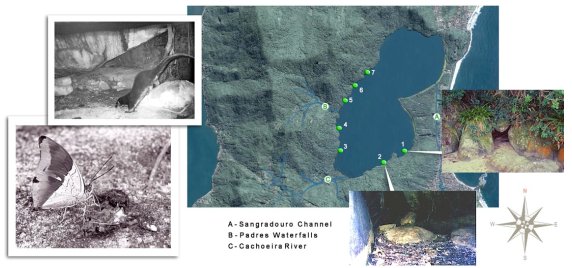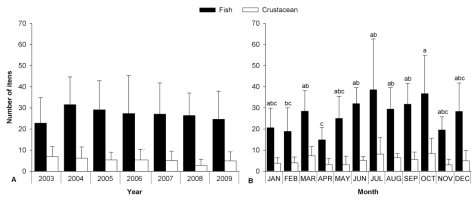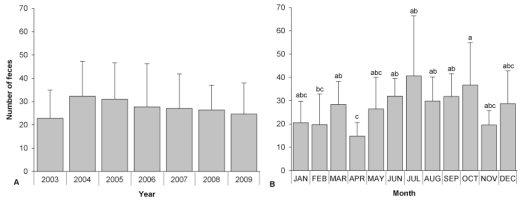IUCN/SSC Otter Specialist Group Bulletin

|
IUCN/SCC Otter Specialist Group Bulletin Volume 27 Issue 2 Pages 59 - 122 (June 2010) Citation: Carvalho-Junior, O., Birolo, A.B. and Macedo-Soares, L.C.P. de (2010). Ecological Aspects of Neotropical Otter (Lontra longicaudis) in Peri Lagoon, South Brazil. IUCN Otter Spec. Group Bull,.27 (2): 105 - 115 Ecological Aspects of Neotropical Otter (Lontra longicaudis) in Peri Lagoon, South Brazil Oldemar Carvalho-Junior1, Alesandra Bez Birolo1,2 and Luis C.P. de Macedo-Soares2,3 1Instituto
Ekko Brasil, IEB, Brazil. Email: atendimento@ekkobrasil.org.br |
 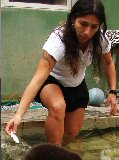  |
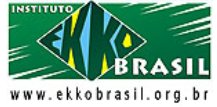 |
|
Abstract: This study presents the monthly and annual diet composition and variability of an otter population living at Peri Lagoon, Santa Catarina Island, South Brazil. Food item proportion through the years and months reveals that fish and crustacean are the main food items, followed by birds and mammals. The results reveal no significant difference in the item fish and crustacean in the diet composition among years. However a difference is found through months for fish abundance in the diet and number of feces, with lowest averages for the month of April. Fish in the family Cichlidae is the main prey in the otter’s diet. |
| Keywords: Lontra longicaudis, diet, distribution, population, shelters, behavior |
| Française | Español | Português |
INTRODUCTION
This study analyzes the role of Neotropical Otter Lontra longicaudis (Olfers, 1818) in the ecosystem of Peri Lagoon, Santa Catarina Island, South Brazil (Figure 1). The main goal is to discuss monthly and annual diet composition and variability of an otter population living in the study area. The research is based on a long-term data set organized for the years 2003-2009, although the species has been studied in the area since 1986 (Carvalho-Junior, 1990).
Lontra longicaudis is a semi-aquatic carnivorous mammal that belongs to the Mustelidae Family and Lutrinae Subfamily (Wilson and Reeder, 2005). The specie is considered critically endangered by the Convention on International Trade in Endangered Species of Wild Fauna e Flora (CITES) and U.S. Endangered Species Act (U.S.E.S.A). In Brazil, the Fauna Protection Law that prohibits the commerce of products made from animals protects the otter.
Although the species is poorly known, perhaps the most studied subject is diet based on spraint analysis. Feces are conspicuous and can be found on the top of rocks, along the water body, including inside shelters, as single mark deposits.
Neotropical Otter can slightly modify some of the preys in the diet, but the final composition does not change, feeding mainly on fishes and crustaceans (Quadros and Monteiro-Filho, 2001; Kasper et al., 2004; Carvalho-Junior, 2007; Carvalho-Junior et al., 2010). Mollusks, small mammals, birds and reptiles complete the diet of the species, but in smaller proportion (Alarcon and Simões-Lopes, 2004; Carvalho-Junior, 2007; Quintela et al., 2008).
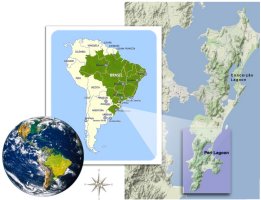 |
| Figure 1. Location of Peri Lagoon, South Brazil. (click for larger version) |
The study area is located at 27°42’S and 48°30’W, in the southeast of Santa Catarina Island, South Brazil (Figure 2). The Peri Lagoon has approximately 5 km2 of water surface, which is maintained mainly by precipitation. Depth average is 6 meters with a maximum of 11 meters. It has a contact with the Atlantic Ocean through a narrow channel with around 4 km long but it is not affected by tides. This channel represents a vital ecological corridor for the local population as the individual use it to reach the ocean and, at least, two other important areas, Lagoinha do Leste Beach and Naufragados Beach (Carvalho-Junior, 2007).
Mountains covered by Atlantic Forest surround the west part of the lake. The east part is a dune field, responsible for isolating the fresh water lake from the ocean. Small streamlets and waterfall flows from the mountains to the lake, creating an ideal environment to the otters.
The otter shelters are formed by Guabiruba intrusive granite, a common rocky formation along the Brazilian south coast, the substrate for the Atlantic Forest. This formation results in semi closed environments, with the outside covered by typical Atlantic Forest vegetation. Roots and humus fill the gaps between rocks.
Peri Lagoon shows a high diversity of fish species, such as Mugil platanus (Günther, 1880), Centropomus parallelus (Poey, 1860), Eucinostomus melanopterus, (Bleeker, 1863), Geophagus brasiliensis (Quoy and Gaimard, 1824), Tilapia rendalli (Boulenger, 1897), Gymnogeophagus rhabdotus (Hensel, 1870) and Hoplias malabaricus (Bloch, 1794) (Carvalho-Junior, 1990; Ribeiro and Marcon, 1999; Mafra et al., 2003; Zank et al., 2010). Geophagus brasiliensis, Gymnogeophagus rhabdotus and Tilapia rendalli are distributed along the margins of the lake. In these areas, aquatic macrophites as Typha domingensis Pers., Fuirena robusta Kunth, Helio ccocharis geniculata and Nymphoides indica (L.) O. Kuntze, are common (Carvalho-Junior, 1990).
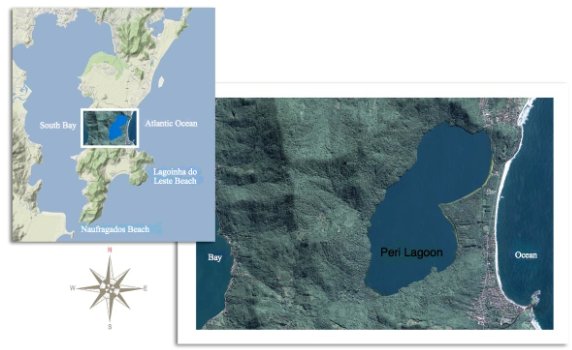 |
| Figure 2. The study area: left - the south part of Santa Catarina Island; right - detail of Peri Lagoon (A small fishermen village can be seen on the bottom of the image). (click for larger version) |
Cichlids like Geophagus brasiliensis, Gymnogeophagus rhabdotus and Tilapia rendalli are easily found among this vegetation, close to the margin. Moreover, Mugil platanus and Centropomus parallelus are more often in open waters of the lake, in constant movement, forming small schools or swimming alone. Hoplias malabaricus is found in small numbers near the shore or in the lower part of the streamlets. A common crustacean in the Peri Lagoon is the freshwater lobsters Macrobrachium carcinus (Linnaeus, 1758) and M. olfersii (Wiegmann, 1836) (Ribeiro and Marcon, 1999). As cichlids, freshwater lobsters are also commonly seen close to the shore.
In Santa Catarina State, Lontra longicaudis can be found from the highlands to the coast, forests, rivers, lakes and costal islands (Quadros and Monteiro-Filho, 2001; Alarcon and Simões-Lopes, 2004; Carvalho-Junior et al., 2010). Otter conservation along the coastal region of Santa Catarina state depends on the conservation of the Atlantic Rain Forest, currently endangered by human activities. Stratification of the forest, along with the high density of epiphytes represents an important contribution to the formation of safe environments for the Lontra longicaudis (Carvalho-Junior et al., 2006).
The main threat for the otter is fragmentation of the environment. Fragmentation results in a mosaic of patches with increasing threat to otter conservation as the distance between patches increases. Neotropical Otters are constantly moving from place to place and they need trustable ecological corridors to complete a safe journey (Carvalho-Junior, 2007).
A second threat is the presence of domestic dogs in the study area. Domestic dogs walk freely along the lake and channels, representing a serious threat as they can transmit diseases as well as chasing and killing wild animals, including otters (Serfass at al., 1995; Boyle, 2006; Park et al., 2007).
MATERIALS AND METHODS
Otter spraints were collected monthly, from 2003 to 2009, along the margin of the Peri Lagoon, including seven shelters (Figure 3). Coordinates for shelters were estimated using a handheld GPS unit (Garmin model GPSmap 60CSx). Margins of the lake were reached by kayaks and canoes.
Feces were collected individually, separated in plastic bags and taken to the lab. In the lab each sample was washed in a mesh and the contents were analyzed with the help of a stereomicroscope. Food items were classified in five categories: fish, mollusk, crustacean, bird and mammal. A table of scales, specific for the study area, was used to identify the fish species present in the feces.
Food item proportion was used to measure the importance of each item in otter’s diet for years and months. It was calculated for each food item using the total number for the food item in relation to the total of all food items. Food item represent each species preyed by Neotropical Otter, identified in the samples. Therefore, food item is a number, for example, a total number of Cichlidae found in the samples during the study time.
Unifactorial ANOVA was applied to test the null hypotheses stating that the main food items consumed by otters and the number of feces do not vary among years and months. Bartlett’s test was conducted to verify the heterogeneity of variances before each analysis and Tukey’s test were applied in order to detect the source of variations. When Tukey’s test did not detect any variations between the means, Newman-Keuls and Duncan tests were used.
After testing for normality, all quantitative data were [log10(x+1)] transformed in order to stabilize the variances and to fit data to a normal distribution (Zar, 1999). All tests were performed using software Statistica© version 7.0 (Statsoft Inc., 1984-2004).
RESULTS
A total of 2805 food items from 2305 feces were analyzed. Number of feces per year varied from 274 to 388 (2003=274, 2004=388, 2005=372, 2006=333, 2007=325, 2008=317, 2009=296). A higher proportion of fish was found (81%). Second item in abundance was crustacean (16%), followed by bird (2%), mammal (2%) and mollusk (less than 1%) (Figure 4).
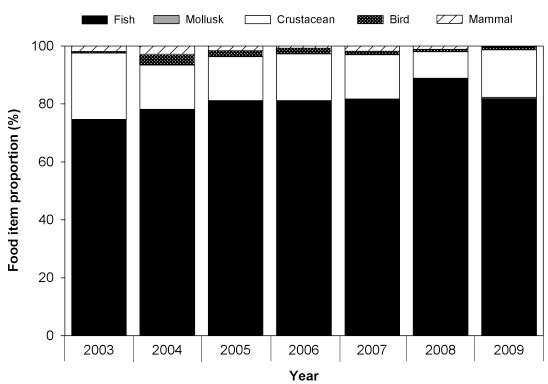 |
| Figure 4. Food item proportion (%) of the otter’s diet composition in the Peri Lagoon from 2003 to 2009. |
The proportion of each food item (fish, crustacean, mollusk, bird and mammal) was analyzed by months for each year (Figure 5). It is quite clear that during the seven years, the higher proportion of the diet were fish followed by crustacean.
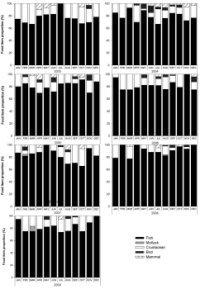 |
| Figure 5. Food item proportion (%) by month and year found in the otter’s feces in the Peri Lagoon, from 2003 to 2009. Click for larger version. |
The scale analysis from the otter feces showed a clear preference for fishes from the Cichlidae family with 79.6% in relation to the total fishes found in the analysis (Figure 6). Mugilidae (1.1%) and Erythrinidae (0.5%) were found in smaller proportion in the diet composition.
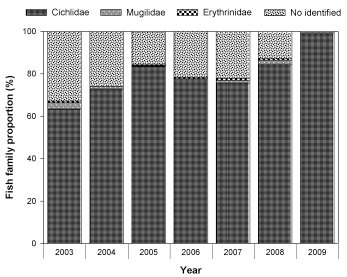 |
| Figure 6. Fish families proportion identified on the otter’s diet at Peri Lagoon. (click for larger image) |
Unifactorial ANOVA reveals no significant difference in the item fish in the diet composition among years (F=0.619; P=0.7141) (Figure 7A). However a difference is found among months (F=2.106; P =0.0305) for fish abundance in the diet (Figure 7B). No significant differences were detected for crustaceans among years (F=1.699; P =0.1324) and months (F=1.231; P =0.2827).
The distribution of otter feces for years and months in the study area did not show any significant differences for number of feces between years (F=0.664, P=0.6789) (Figure 8A). However, differences in months were found (F=2.018, P=0.0388). October represents the highest average abundance of feces (July presents a large standard deviation) and April the lowest (Figure 8B).
DISCUSSION
In the study area, Lontra longicaudis shows a clear preference for fish and crustacean. Similar results were found in other places of South Brazil, such as rivers (Quadros and Monteiro-Filho, 2001; Kasper et al., 2004; Kasper et al., 2008) and coastal areas (Colares and Waldemarin, 2000; Alarcon and Simões-Lopes, 2004; Carvalho-Junior, 2006; Quintela et al., 2008; Carvalho-Junior et al., 2010).
A higher contribution of fish in the diet (81%) is reported for other locations in Southern Brazil, such as in Taquari Valley with 89% (Kasper et al., 2004), in the Environmental Protected Area of Anhatomirin with 87% (Alarcon and Simões-Lopes, 2004) and in a coastal stream in Rio Grande do Sul state with 83% (Quintela et al., 2008). Birds and mammals are also registered in these areas as preys with lowest contribution in the otter’s diet. On the other hand mollusks was the third most important item in otter’s feces collected in Conceição Lagoon (Carvalho-Junior et al., 2010), but lowest in two other coastal areas in southern Brazil (Alarcon and Simões-Lopes, 2004; Quintela et al., 2008), as in this study.
The monthly variation from 2003 to 2009 presents significant differences for the item fish, as well as number of feces. Both differences occur in April, the lowest average number of fish item and number of feces. As the main prey for otters in the study area is fish, it could be proportional to number of feces.
A similar study as the one conducted here was carried out in Conceição Lagoon (Carvalho-Junior et al., 2010). This study did not show any significant differences in diet composition and feces number, yearly nor monthly. The research in the Conceição Lagoon was from 2004 to 2008. A total of 2516 feces were collected in the Conceição Lagoon for five years while 2305 feces were collected in the Peri Lagoon for seven years.
An average of 1.2 item per feces is found in the study area. This could be related to the size of the prey. Field observations in the study area suggest that the size of Cichlidae predated by the otters normally weights from 300g to 400g. It is also observed in the field, and in captivity, that the specie normally preys one species at the time. It is rare to find two types of items in only one feces.
Among fish populations in Peri Lagoon, Lontra longicaudis preys mainly Cichlidae (79.6%). The preference for Cichlidae was also recorded by Quintela et al. (2008) with 72% of the fishes in the otter’s diet, and by Quadros and Monteiro-Filho (2001) with 27%. In Taquari Valley, Cichlidae was the second most consumed fish by otters (Kasper et al., 2004), and in a marine coastal area, Cichlidae was replaced by Sciaenidae as the main item in the otter’s diet (Alarcon and Simões-Lopes, 2004).
Despite the low contribution from Erythrinidae in the total fish consumed by otters in Peri Lagoon, this family was an important food resource for the otters in Bolacha Arroio, Rio Grande do Sul State (Quintela et al., 2008), and may be one of the most consumed fish in the diet in Itapoá, Santa Catarina State (Quadros and Monteiro-Filho, 2001). Like in Peri Lagoon, Mugilidae was also registered in otter’s diet in coastal streams in Rio Grande do Sul State (Quintela et al., 2008).
The occurrence of Cichlidae in the feces does not indicate any sign of seasonality. In Peri Lagoon, Cichlidae was the most abundant family with 51.7% of the total number of fish caught (Ribeiro and Marcon, 1999). According to the authors, Geophagus brasiliensis occur throughout the year and Tilapia rendalli was abundant mostly in autumn and winter months. In a recent study conducted in spring, Gymnogeophagus rhabdotus was also found in the lake (Zank et al., 2010). Among eurihalines fishes, Mugil platanus, Centropomus parallelus and Eucinostomus melanopterus (Ribeiro and Marcon, 1999), are common in the lake. Erythrinidae is seen regularly in the Cachoeira River, south of the lake, while catfishes such as the genus Rhamdia and Pimelodus can also be found in the channel.
Crustaceans represent the second most important item in food item proportion. The presence of crustacean such as Macrobrachium spp. in the feces is normally mixed with fish, and in some cases might be the most important item in the diet (Kruuk, 2006). In Peri Lagoon, genus Macrobrachium are represented by the species M. olfersii and M. carcinus, and they are often in the margins of the lake, near rocks or macrophytes (Ribeiro and Marcon, 1999). In other freshwater environments, a freshwater crab such as Trichodactylus fluviatilis (Latreille, 1828) was also found in otter’s feces (Quadros and Monteiro-Filho, 2001), and in marine coastal areas, crustaceans are represented by Grapsidae, Xantidae and Portunidae crabs (Colares and Waldemarin, 2000; Alarcon and Simões-Lopes, 2004; Quintela et al., 2008).
Birds represent a minor item in the otter’s diet, with 2% item proportion. The most common feather found is the one from Phalacrocoracidae family, Phalacrocorax brasilianus (Gmelin, 1789) (Neotropic Cormorant). Phalacrocorax takes some time when trying to leave the water surface, which might facilitate the otter’s job (Figure 9). Another bird found in otter feces is the Jacana jacana (Linnaeus, 1766) (Wattled Jacana). Mammal hairs can also been seen in the feces (Figure 9). In some studies, the order Rodentia was the most representative group in the mammals prey by otters (Quadros and Monteiro-Filho, 2001; Alarcon and Simões-Lopes, 2004).
The knowledge of the behavior of the preys might reveal hunting strategies from the predator. Why, in the study area, the Neotropical Otter preys more on Cichlidae fishes, compared to Mugil sp. or Centropomus undecimalis? A quick analysis of the ecology of these species shows that Cichlidae fishes have a limited capacity of motion, being mainly restricted to the margin of the lake, close to rocks and aquatic macrophytes. On the other hand, Mugil sp. and Centropomus undecimalis, less important in the otter’s diet, are cruiser species, swimming around the entire lake.
The results indicate that Neotropical Otters in the study area are mainly specialist, with a clear preference on fishes, followed by crustaceans. However, more studies on this matter is needed, including different areas, in order to detect possible differences in otter’s diet composition.
Acknowledgements - We would like to acknowledge Marcelo Tosatti for coordinating the fieldwork and Neno Brazil for the location maps. We are most grateful to Tammy Snyder for the comments and review of the text and to Gaelle Moisand Lachenal who kindly translate the abstract to French. This work was realized under the auspices of Programa Petrobras Ambiental, with the support of Ecovolunteer Program, Floram (Environmental County Foundation), IBAMA (Brazilian Institute of Environment) and Environmental Police of Santa Catarina state. Finally we thank the comments and suggestions made by the anonymous reviewers, which improved significantly the quality of the paper.
REFERENCES
Alarcon, G.G., Simões-Lopes, P.C. (2004). The Neotropical otter Lontra longicaudis feeding habits in a marine coastal area, Southern Brazil. IUCN Otter Spec. Group Bull. 21(1): 24-30.
Boyle, S. (2006). North American river otter (Lontra canadensis): a technical conservation assessment. [Online]. USDA Forest Service, Rocky Mountain Region. Available: http://www.fs.fed.us/r2/projects/scp/ assessments/northamericanriverotter.pdf [20.08.2010].
Carvalho-Junior, O. (1990). Aspectos da autoecologia de Lutra longicaudis (Olfers, 1818) no ecossistema da Lagoa do Peri, SC, Brasil. Tese de Dissertação em Hidroecologia. UFSC, Departamento de Biologia. 94 p.
Carvalho-Junior, O. (2004). Spatial organization of river otter Lontra longicaudis in the south of Santa Catarina Island, Brazil. In: 11 Reunion de Trabajos de Especialistas en Mamiferos Acuaticos de America del Sur, 2004, Quito, Ecuador, p. 63-63.
Carvalho-Junior, O., Banevicius, N.M.S., Mafra, E.O. (2006). Distribution and Caracterization of Environments Used By Otters. Journal of Coastal Research, 39: 1087-1089.
Carvalho-Junior, O. (2007). No Rastro da Lontra Brasileira. Bernuncia, Florianópolis, Brasil, 112pp.
Carvalho-Junior, O., Macedo-Soares, L.C.P, Birolo, A.B. (2010). Annual and interannual food habits variability of a Neotropical otter (Lontra longicaudis) population in Conceição Lagoon, South of Brazil. IUCN Otter Spec. Group Bull. 27(1): 24-32.
Colares, E.P., Waldemarin, H.F. (2000). Feeding of the neotropical otter (Lontra longicaudis) in the coastal region of the Rio Grande do Sul State, Southern Brazil. IUCN Otter Spec. Group Bull. 17(1): 6-13.
Kasper, C.B., Feldens, M.J., Salvi, J., Grillo, H.C.Z. (2004). Estudo Preliminar sobre a ecologia da Lontra longicaudis (Olfers) (Carnivora, Mustelidae) no Vale do Taquari, Sul do Brasil. Rev. Bras. Zool. 21(1): 65-72.
Kasper, C.B., Bastazini, V.A.G., Salvi, J., Grillo, H.C.Z. (2008). Trophic ecology and the use of shelters and latrines by the Neotropical Otter (Lontra longicaudis) in the Taquari Valley, Southern Brazil. Iheringia 98(4): 469-474.
Kruuk, H. (2006). Otters: ecology, behavior and conservation. Oxford University Press, New York, 265pp.
Mafra, E.O., Banevicius, N.M.S., Schmidt, A., Carvalho-Junior, O. (2003). Aspectos Ecológicos da Dieta Alimentar da Lontra (Lutra longicaudis, Olfers 1818) e a Comunidade de Peixes da Lagoa do Peri (SC, Brasil). In: IX Congresso Brasileiro de Limnologia, 2003, Juiz de Fora. Apresentação em Painéis. Juiz de Fora: UFJF, 2003. 0673. 1 CD-ROM (a).
Park, N.Y., Lee, M.C., Kurkure, N.V., Cho, H.S. (2007). Canine adenovirus type 1 infection of a Eurasian river otter (Lutra lutra). Vet. Pathol. 44:4.
Quadros, J., Monteiro-Filho, E.L.A. (2001). Diet of the neotropical otter, Lontra longicaudis, in the Atlantic Forest, Santa Catarina State, Southern Brazil. Stud. Neotrop. Fauna Environ. 36(1): 15-21.
Quintela, F.M., Porciúncula, R.A., Colares, E.P. (2008). Diet of Lontra longicaudis (Olfers) in a coastal stream in southern Rio Grande do Sul State, Brazil. Neotrop. Biol. Cons. 3(3): 119-125.
Ribeiro, G.C., Marcon, E.H. (1999). Composição e estrutura da comunidade de peixes e de crustáceos na Lagoa do Peri, Ilha de Santa Catarina. In: NEMAR. Diagnóstico ambiental visando um programa de monitoramento da Lagoa do Peri, Ilha de Santa Catarina, SC. v. II. Programa Institucional de Estudo de Sistemas Costeiros – PIESC, Universidade Federal de Santa Catarina, Florianópolis, Brasil, p. 280-311.
Serfass, T.L., Whary, M. T., Peper, R. L., Brooks, R. P., Swimley, T.J., Lawrence, W. R., Rupprecht, C.E. (1995). Rabies in a river otter (Lutra canadensis) intended for reintroduction. Journal of Zoo and Wildlife Medicine, 26(2): 311-314.
Walker, E.P. (1975). Mammals of the world. Baltimore: Johns Hopkins. 1500p.
Wilson, D.E. and Reeder, D.M. (2005). Mammal Species of the World: a taxonomic and geographic reference. 3a ed., The Johns Hopkins University Press, Baltimore, Maryland, 1945 pp.
Zank, S., Corso, G., Costa-Araújo, R., Macedo-Soares, L.C.P, Martins, C.D.L, Saccol-Pereira, A. (2010). Variação diuturna da assembléia de peixes na costa nordeste da lagoa do Peri, ilha de Santa Catarina, sul do Brasil. In: Cantor, M., Macedo-Soares, L.C.P., Hanazaki, N. (orgs). Ecologia de Campo na Lagoa do Peri (2009), Florianópolis: Programa de Pós-Graduação em Ecologia/Universidade Federal de Santa Catarina, 193pp., in press.
Zar, J.H. (1996). Biostatistical analysis. 3 ed. Prentice Hall, New Jersey. 662pp.
Résumé : Ecologie des Lontra longicaudis dans Lagoa do Peri, Sud du Brésil
Ce travail porte sur la composition du régime alimentaire mensuel et annuel, et la variabilité, d'une population de loutres vivant au lac do Peri, sur l'île de Santa Catarina, au Sud du Brésil. La proportion des différents éléments de nourriture à travers les années et les mois révèle que les poissons et les crustacés sont les principaux éléments, suivis par les oiseaux et les mammifères. Les résultats ne révèlent pas de différence significative entre les poissons et les crustacés dans la composition du régime alimentaire entre les années. Cependant, il existe une différence entre les mois pour la proportion des poissons, et aussi le nombre de fèces. Le mois d'Avril est celui qui comporte la plus faible moyenne. Enfin, les Cichlidae sont les principales proies dans le régime alimentaire des loutres.
Revenez au dessus
Resumen: Ecología de Lontra longicaudis en Lagoa do Peri, sur de Brasil
Este trabajo estudia la composición y variabilidad mensual y anual de la dieta de una población de nutria que vive en Lagoa do Peri, Isla de Santa Catarina, al sur de Brasil. Proporción de los ítems alimentos a través de los años y meses revela que los peces y crustáceos son los alimentos principales, seguidos por las aves y los mamíferos. Los resultados non revelan diferencias significativas en los ítems peces y crustáceos en la composición de la dieta entre años. La diferencia se encuentra a través meses para la abundancia de peces en la dieta y la cantidad de heces. Mes de abril es responsable por la diferencia que presenta el promedio más bajo. Cichlidae es la presa principal en la dieta de la nutria.
Vuelva a la tapa
Resumo: Aspectos ecológicos
da lontra de Neotropical (Lontra longicaudis) na lagoa do Peri,
Brasil sul
Este estudo apresenta a composição, e variação
mensal e anual da dieta de uma população de lontras vivendo
na Lagoa do Peri, Ilha de Santa Catarina, Sul do Brasil. Proporção
do item alimentar ao longo dos meses e anos revela que peixes e crustáceos
são os principais alimentos, seguidos por aves e mamíferos.
Os resultados não demonstram haver diferença significativa
no número de peixes e crustáceos na composição
da dieta entre os anos. No entanto, é observado diferenças
através dos meses para a abundância de peixes na dieta
e do número de excrementos, com menores médias para o
mês de abril. Os peixes da família Cichlidae são
as principais presas na dieta da lontra.
